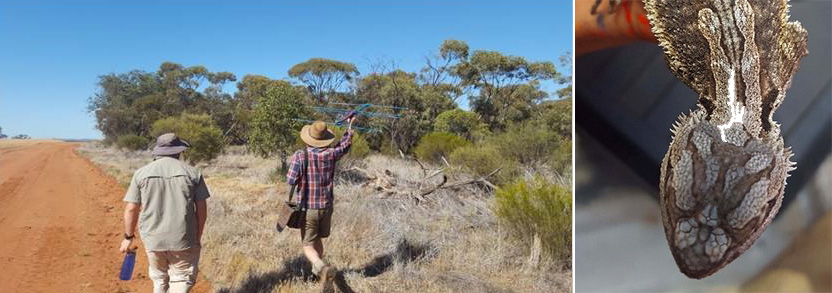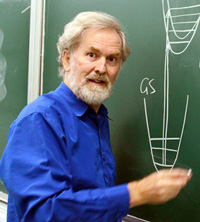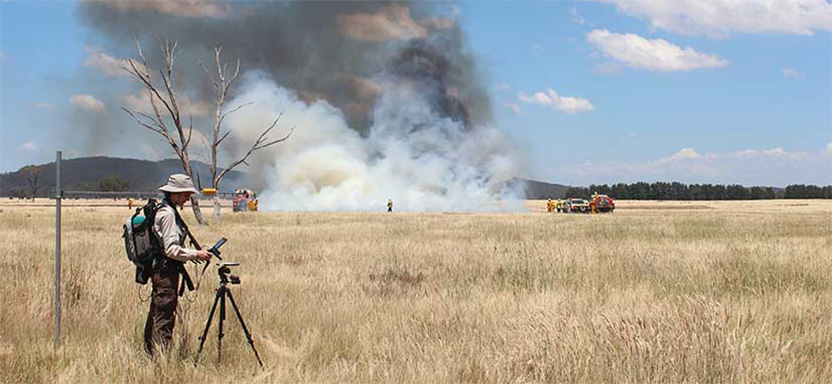
‘In this project I studied reptile community abundance and dragon spatial ecology in fragmented farming landscapes containing remnant mallee woodlands in central New South Wales.
Throughout this project I was assisted by 20 volunteers who I trained in field techniques. I also trained an honours student who collected some of the bearded dragon tracking data. I provided regular updates from the field via Twitter, including posting photos of our study area and species. I engaged with local farmers about the study aims and findings. This award enabled me to undertake the radio-tracking component of this research, which otherwise would not have been possible.’

‘Winning the Craig prize provided a wonderful opportunity for me in three respects.
First, I was the last student of Ian Ross FAA, who was also the first student of David Craig. As one of the few remaining active Australian academics to have been strongly influenced by Craig, the medal provided a great opportunity for me to remind Australia about his achievements. I visited 26 institutions, many of which told me that they had never had a Craig medallist lecture there before.
Second, I was able to connect my research with many Australian researchers in physics and chemistry. Good feedback received from many institutions helped me refine my ideas, and extensive discussion following lectures at Latrobe and Griffith universities led to new research projects, one of which was published in Nature Reviews Chemistry, the other in the Proceedings of the US National Academy of Sciences, attracting significant media attention. A clear message from this is that good science in Australia is not just confined to famous people at top-named institutions, but instead happens all over the country.
Thirdly, the Craig medal allowed me to give thanks to all science teachers across Australia for their hard work and inspiration that has led to Australia’s strengths in science and technology.’

‘Thanks to the Max Day Environmental Science Fellowship Award, we have been able to advance our scientific understanding and techniques to relate satellite observations to fuel moisture content. Specifically, the award has allowed me to develop and use our newly developed forest spectroscope. This is a sophisticated instrument that makes detailed measurements of light in wavelengths beyond that visible to the human eye, while at the same time collecting thermal images and laser scans of the canopy. The resulting data have very high spatial and spectral resolution, making it possible to distinguish individual leaves in the canopy.
The award made it possible to simultaneously collect leaf samples for biochemical analysis, which we can then relate back to the spectral measurements. The insights from that will be used directly to create more accurate models to estimate the moisture content of Australian eucalypt forests from satellite observations.
These will further improve the satellite-based fuel moisture content maps currently already available from our Australian Flammability Monitoring System website. Fire and land managers use this information as inputs in the new National Fire Danger Rating System and for other critical fire management decisions.
Also, thanks to award, I presented my research advances at the 38th annual symposium of the IEEE Geoscience and Remote Sensing Society in Europe in July.’
In May this year, recipients of the Boden Research Conference award, Dr Dana Bergstrom of the Australian Antarctic Division and Dr Justine Shaw of the Centre for Biodiversity and Conservation Sciences, University of Queensland, held a conference on Ecological Surprises and Rapid Collapse of Ecosystems in a Changing World at the Shine Dome in Canberra.
Learnings from the conference included how common rapid ecosystem change is, that a diverse range of ecosystems across Australia (and beyond) are collapsing, and that additive elements are causing major collapse.
There were 85 delegates with 50 oral presentations, 20 given by early- and mid-career researchers. There were more female than male presenters. These targets were achieved by the conveners actively seeking out early- and mid-career female scientists to present their work. The conference offered free child care.
According to fundraising expert Jeff Brooks, about one-third of individual income to professional fundraising charities in Australia comes from regular giving. The Pareto Fundraising Benchmarking 2016 report, which studied the data from 48 different charities, supports this estimate—confirming how an ongoing commitment from donors is crucial for a charity’s longevity and stability. The Academy would like to thank our regular donors for their continued support of our work and invite others who might like to donate through regular monthly donations to visit our website (www.science.org.au/donate) or contact our Manager Development and Stewardship, Isobel Griffin on 02 6201 9400 to discuss your options for monthly giving.
Thank you to all our valued partners and sponsors, without whose support we could not achieve many of the things we do.
© 2025 Australian Academy of Science